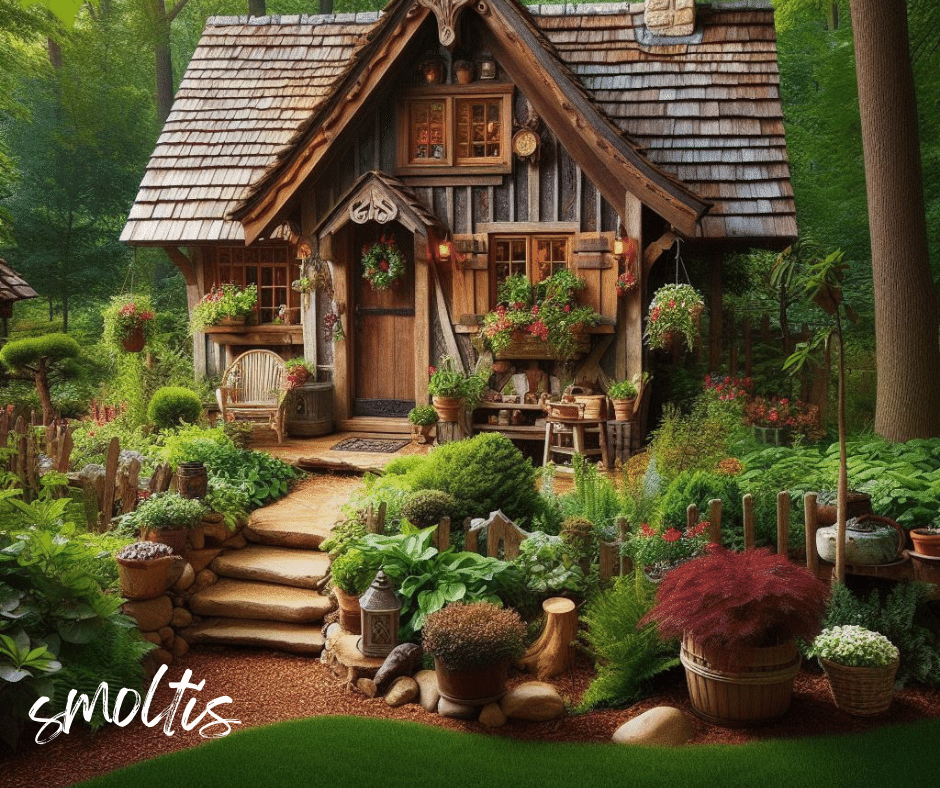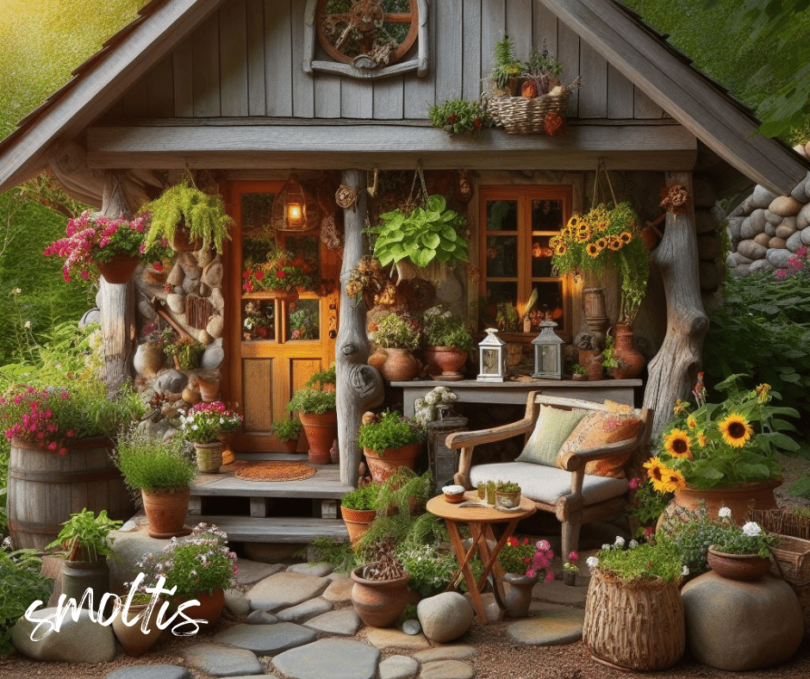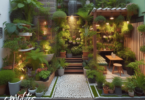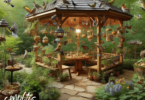Transform your shade gardens into serene retreats with the allure of cottage charm. By embracing rustic themes, you can create a cozy and inviting atmosphere that blends seamlessly with the natural beauty of shaded spaces. In this article, we will explore tips and ideas for designing enchanting shade gardens that embody the essence of cottage living.

Key Takeaways:
- Add rustic elements to your shade garden to enhance the cottage charm.
- Choose shade-tolerant plants that thrive in low light conditions.
- Create a balanced and aesthetically pleasing shade garden design.
- Utilize low light garden plants to enhance the overall beauty of the rustic theme.
- Maintain the vitality of your shade garden through proper care and maintenance practices.
Designing Enchanting Shade Gardens
Designing a shade garden that is both enchanting and visually appealing requires careful consideration and thoughtful planning. By selecting the best plants for shade gardens and incorporating shade-tolerant plants into the design, you can create a serene and rustic oasis in your outdoor space.
When it comes to shade garden design, it’s important to choose plants that thrive in low light conditions. Opt for foliage plants that add depth and texture to the space, such as ferns, hostas, and heucheras. These shade-loving plants not only bring life to the garden but also provide an attractive backdrop for other complementary flowers and shrubs.
To create a balanced and aesthetically pleasing shade garden design, it’s advisable to vary the heights, textures, and colors of the plants. Consider using taller plants at the back of the garden to create depth and layering, while shorter plants can be placed towards the front to draw the eye in. Incorporating flowering plants like impatiens, bleeding hearts, and astilbes can add pops of color and visual interest.
To further enhance the rustic theme in your shade garden, incorporate shade-tolerant plants that are known for their cottage charm. Some popular choices include foxgloves, hydrangeas, and hellebores. These plants not only thrive in shaded areas but also contribute to the overall aesthetic of the garden, creating a serene retreat with their delicate blooms and lush foliage.
Here is a list of the best plants for shade gardens:
- Ferns
- Hostas
- Heucheras
- Impatiens
- Bleeding hearts
- Astilbes
- Foxgloves
- Hydrangeas
- Hellebores
By incorporating these shade-tolerant plants into your garden design, you can create a beautiful and enchanting space that embraces a rustic theme. The combination of foliage plants, flowering plants, and shade-loving cottage-style plants will ensure that your shade garden is a tranquil haven of natural beauty.
Embracing Rustic Elements in Shade Gardens
Creating a shady garden with rustic themes can transform any outdoor space into a charming and inviting retreat. By integrating various rustic elements, such as weathered wood, stone pathways, and vintage containers, you can enhance the cottage charm and create a cozy atmosphere in your shade garden.
Rustic themes:
One of the key aspects of designing a shade garden with rustic themes is to incorporate natural, weathered materials. Weathered wood, for example, can be used to create raised beds, benches, or trellises that add a rustic touch to the space. It blends well with the lush foliage and creates a harmonious blend of textures.
Stone pathways are another wonderful addition to a rustic shade garden. Use natural stones to create a winding path that guides visitors through the garden, adding an enchanting and meandering element. They not only provide functionality but also contribute to the overall rustic aesthetic.
Shade garden ideas:
When it comes to shade garden ideas, think about incorporating vintage containers to hold and display your shade-loving plants. Consider using old metal watering cans, wooden crates, or antique pots to add a touch of nostalgia to your garden. These vintage containers not only serve as functional planters but also become charming focal points in the landscape.
Integrating rustic elements in your shade garden creates a sense of history and nostalgia, turning it into a tranquil oasis. By incorporating weathered wood, stone pathways, and vintage containers, you can achieve a rustic theme that enhances the cottage charm and brings a cozy, inviting vibe to your outdoor space.
Get inspired by the following shade garden ideas:
- Create a seating area with an old wooden bench surrounded by shade-tolerant plants. Add soft cushions and blankets for a cozy and rustic feel.
- Hang vintage lanterns or string lights from tree branches to create a magical ambiance in the evenings.
- Use reclaimed wooden ladders as trellises for climbing plants, adding height and visual interest to your shade garden.
- Plant ferns and mosses in between stepping stones to add a lush and natural touch to your stone pathways.
Incorporating these shade garden ideas will help you create a shady garden that is not only visually appealing but also an inviting retreat.
| Rustic Elements | Benefits |
|---|---|
| Weathered Wood | Blends well with foliage, adds texture, and brings a rustic touch |
| Stone Pathways | Creates a meandering and enchanting element, adds functionality and visual appeal |
| Vintage Containers | Serves as planters and focal points, adds nostalgia and charm |
Landscaping with Shade Plants
When it comes to creating a picturesque shade garden, choosing the right plants is crucial. Landscaping with shade plants not only adds beauty but also enhances the rustic theme of your garden. Whether you have a small corner or an extensive shaded area, low light garden plants can thrive and bring life to your outdoor space.
One of the key considerations in landscaping with shade plants is selecting varieties that can tolerate low light conditions. These low light garden plants are specially adapted to thrive in shady areas, making them ideal choices for your shade garden. From delicate ferns to vibrant hostas and graceful astilbes, there is a wide range of shade-tolerant plants available to suit your design preferences.
When planning your shade garden, it’s important to understand the different levels of shade and choose plants accordingly. Some areas may receive dappled light throughout the day, while others may be in deep shade for most of the time. By identifying the specific light conditions in each area, you can select plants that are well-suited to thrive in those conditions.
In addition to choosing the right plants, implementing shade landscaping solutions can help overcome common challenges faced in shade gardens. Creating layered planting beds can maximize the use of space, ensuring that each plant receives the appropriate amount of light. Adding mulch to the soil helps retain moisture and regulate soil temperature, providing optimal growing conditions for shade plants.
Shade Landscaping Solutions:
- Select shade-tolerant plants that can thrive in low light conditions.
- Identify different levels of shade in your garden and choose plants accordingly.
- Create layered planting beds to maximize space and light availability.
- Apply mulch to retain moisture and regulate soil temperature.
By incorporating landscaping with shade plants and implementing shade landscaping solutions, you can create a stunning and vibrant shade garden that complements your rustic theme. Whether you prefer a serene retreat adorned with delicate blooms or a lush green oasis, thoughtful plant selection and strategic landscaping techniques will bring your vision to life.
| Low Light Garden Plants | Description |
|---|---|
| Hostas | Known for their broad foliage in various shades of green, hostas add texture and elegance to shade gardens. |
| Ferns | With their delicate, feathery fronds, ferns bring a sense of airiness and charm to shaded areas. |
| Astilbes | These feathery plume-like flowers in soft hues of pink, white, and red provide a striking contrast against lush green foliage. |
| Bleeding Hearts | With their heart-shaped flowers dangling from arching stems, bleeding hearts add a touch of whimsy and romance to shade gardens. |
| Heucheras | Known for their vibrant foliage in shades of purple, green, and bronze, heucheras offer year-round interest in shade gardens. |
Maintaining the Beauty of Shade Gardens
Creating a beautiful shade garden filled with rustic charm is just the beginning. To ensure the longevity and vitality of your serene retreat, proper care and maintenance are essential. By following these expert tips for shade garden maintenance and caring for shade plants, you can keep your rustic-themed oasis thriving year-round.
Watering:
Proper watering is crucial for shade gardens, as excessive moisture or dry conditions can harm shade-tolerant plants. Monitor the moisture levels regularly and ensure that the soil remains consistently moist, but not waterlogged. Deep, infrequent watering sessions are more effective than frequent shallow watering, as they encourage plants to develop deep, robust root systems.
Fertilizing:
Regular fertilization is essential to provide shade plants with the necessary nutrients for healthy growth. Use a slow-release organic fertilizer specifically formulated for shade-tolerant plants. Apply the fertilizer according to the package instructions, usually once or twice a year, during the growing season. This will help promote vibrant foliage and abundant blooms in your shade garden.
Pests and Diseases:
Even in shaded areas, plants can be susceptible to pests and diseases. Monitor your shade garden regularly for signs of common pests such as slugs, snails, and aphids. Consider using organic pest control methods to minimize any potential damage. Additionally, inspect the leaves and stems for any signs of diseases such as powdery mildew or leaf spot. If detected, remove affected foliage promptly to prevent the spread of infection.
Proper Pruning:
Pruning is an essential aspect of shade garden maintenance. Regularly inspect your plants and remove any dead, damaged, or diseased foliage. Prune overgrown branches to maintain the desired shape and size of your shade garden. Proper pruning promotes air circulation and sunlight penetration, reducing the risk of pests and diseases while ensuring healthy and vigorous growth.
Mulching:
Applying a layer of organic mulch around your shade plants has multiple benefits. Mulch helps conserve moisture, regulates soil temperature, suppresses weeds, and adds a decorative element to your rustic-themed shade garden. Apply a 2-3 inch layer of mulch around the base of your plants, taking care to keep the mulch away from direct contact with the stems, as it can lead to rot.
Expert Tip: Regular maintenance tasks such as weeding and removing fallen leaves are equally important for shade gardens. These simple steps help promote a clean and tidy appearance while preventing competition for nutrients and reducing the risk of pests and diseases.
By incorporating these shade garden maintenance practices into your routine, you can provide the care and attention your rustic-themed shade garden deserves. With proper watering, fertilizing, pest management, pruning, and mulching, your shade plants will flourish, creating a serene retreat that exudes cottage charm.
Conclusion
Creating a shade garden with a rustic theme is the perfect way to transform a shaded space into a serene retreat. Throughout this article, we have explored various tips and ideas for designing enchanting shade gardens that exude cottage charm. By embracing rustic elements and carefully selecting shade-tolerant plants, you can achieve a balanced and visually appealing shade garden design.
Landscaping with shade plants allows you to overcome the challenges of low light conditions and create a lush and inviting outdoor space. By incorporating weathered wood, stone pathways, and vintage containers, you can enhance the rustic theme and evoke a sense of coziness in your shady garden.
To maintain the beauty of your shade garden, it is essential to provide proper care and maintenance. Regular watering, appropriate fertilization, and vigilance against pests and diseases specific to shade-tolerant plants are crucial. By nurturing your plants and tending to your garden’s needs, you can ensure the longevity and vitality of your rustic-themed shade garden.
In conclusion, shade gardens with rustic themes offer a peaceful and inviting retreat within the embrace of nature. By following the tips and ideas discussed in this article, you can embark on your own cottage charm journey and create a stunning shade garden that becomes a sanctuary of tranquility and beauty.
FAQ
What is the concept of designing shade gardens with a rustic theme?
Designing shade gardens with a rustic theme involves integrating natural, weathered elements to create a serene retreat in shaded spaces. It combines the charm of cottage-style gardens with the beauty of shade-tolerant plants.
What are some tips for designing shade gardens?
When designing a shade garden, it is important to choose plants that thrive in low light conditions. Consider the levels of shade available and select a variety of shade-tolerant plants to create texture and depth. Creating a balanced layout with pathways, seating areas, and focal points can also enhance the overall design of the shade garden.
How can I incorporate rustic elements into a shade garden?
To embrace rustic elements in a shade garden, consider using weathered wood for fences, trellises, or raised beds. Incorporate stone pathways or stepping stones to create a charming walkway. Vintage containers and antique garden tools can add a touch of nostalgia. Additionally, incorporating elements like rustic benches or hammocks can create cozy seating areas within the shade garden.
What are some low light garden plants that can be used for shade gardens?
When landscaping with shade plants, consider using ferns, hostas, astilbes, and hellebores. These plants thrive in low light conditions and add lush foliage with various textures and colors. Other options include bleeding hearts, coral bells, and foamflowers. Consulting with a local garden center or expert can provide more specific recommendations based on your region.
How do I maintain shade gardens?
Shade gardens require regular watering to keep the soil moist, but not waterlogged. Applying a layer of organic mulch can help retain moisture and suppress weeds. Fertilizing shade-tolerant plants during the appropriate seasons will promote healthy growth. Regularly inspecting plants for signs of pests or diseases and promptly addressing any issues will help maintain the beauty of the shade garden.







